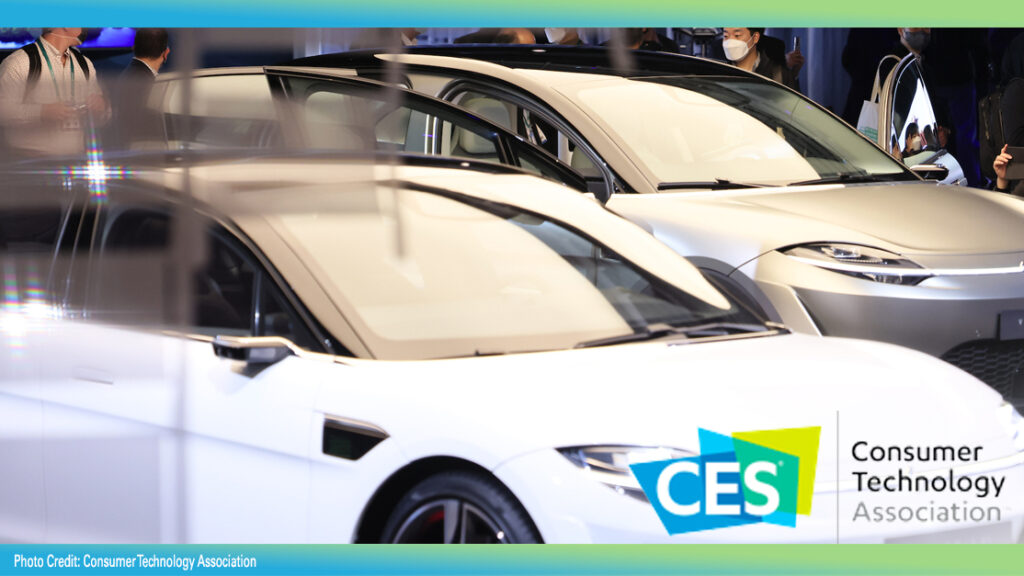

This year, CES returned to an in-person format, welcoming more than 45,000 attendees to Las Vegas, January 5 – 8. Fortunately, the event maintained the Digital Venue which is how Komal Doshi, Ann Arbor SPARK director of mobility explored the event. While there was a lot to discover, according to Komal there were five key themes that emerged.
Deluge of EVs
There is a growing number of electric vehicle (EV) announcements with some brands setting timelines to turn fully electric.
- GM announced a few new models including the 2024 Chevrolet Silverado EV and the 2024 Equinox EV.
- Others shared concept cars like the Mercedes-Benz’s Vision EQXX, Sony’s Vision-S 02 electric crossover, BMW iX Flow, and Chrysler’s Airflow Vision.
- Even the EV micromobility space gets smarter — check out this piece from TechCrunch.
AVs Ride the Coattails of EV Announcements
As automakers declare their commitments to electric, many continue to tie these developments to future ambitions for autonomous vehicles (AV). New partnerships were announced as car manufacturers work to enhance their AV offerings.
- GM is hoping its Ultra Cruise will take on Tesla’s Full Self-Driving (FSD). GM is working with Qualcomm to help develop its AV business.
- Intel’s autonomous driving unit Mobileye has entered a partnership with Volkswagen, Ford, and Geely.
- Nvidia’s DRIVE AGX Orin system-on-a-chip (SoC) will be powering TuSimple and Volvo automated driving features.
Metaverse + Mobility = Metamobility
Metaverse is a hot topic, and it was only a matter of time until it collided with the mobility industry.
- Hyundai shared its vision of “expanding human reach” through metaverse and robotics. This vision of physical reality merging with the digital universe will impact our daily mobility needs and experiences. Qualcomm’s new partnerships with carmakers and Microsoft signals a firm push into both the automotive chip and emerging metaverse markets.
Building Modular Robots
Manufacturers are developing platforms to scale delivery robots.
- Hyundai’s Plug and Drive (PnD) robotic module can enable mobility of things at a very different scale than it could previously. The PnD module can provide mobility to everything from small objects to community spaces with infinite flexibility and scalability.
- LG showed off revamped “CLOi” service robots. Three models are available – the GuideBot (for customer service), the ServeBot (a serving partner), and the door-to-door delivery robot (for, you guessed it, deliveries).
Smart Cockpits and Improved Customer Experiences
CES 2022 had its fair share of partnership announcements that focused on the continued enhancement of the digital cockpit and an improved customer experience.
- Stellantis announced an extensive partnership with Amazon to develop a next-generation STLA Smart Cockpit.
- Qualcomm partners with Renault, Volvo, Honda for digital transformation through Snapdragon Digital Chassis.
- Volvo and Google announced new content and services that will be coming to future Volvo vehicles, including the ability to download and use the YouTube app via Google Play Store and the ability to communicate with the Google Home ecosystem.
Conclusion
Consumer needs are at the center of CES and it’s clear those needs are driving R&D decisions.
- EV models are filling the latent market demand — a demand fueled by President Biden’s infrastructure bill that was signed into law in November and followed by Governor Gretchen Whitmer’s executive directive (ED) to build up electric vehicle charging infrastructure and create good-paying, clean energy jobs.
- The pandemic has highlighted the opportunity for robotics and automation to improve our lives. The modular and platform nature of these newer versions will only improve their cost economics and allow them to cater to the unique use cases of the consumers.
- The pandemic has also highlighted our need to stay connected digitally when we can’t be together physically. The metaverse might be a distant vision but the desire to better connect the physical and digital ecosystems will continue to dominate the conversations and solutions we see being proposed in coming years.